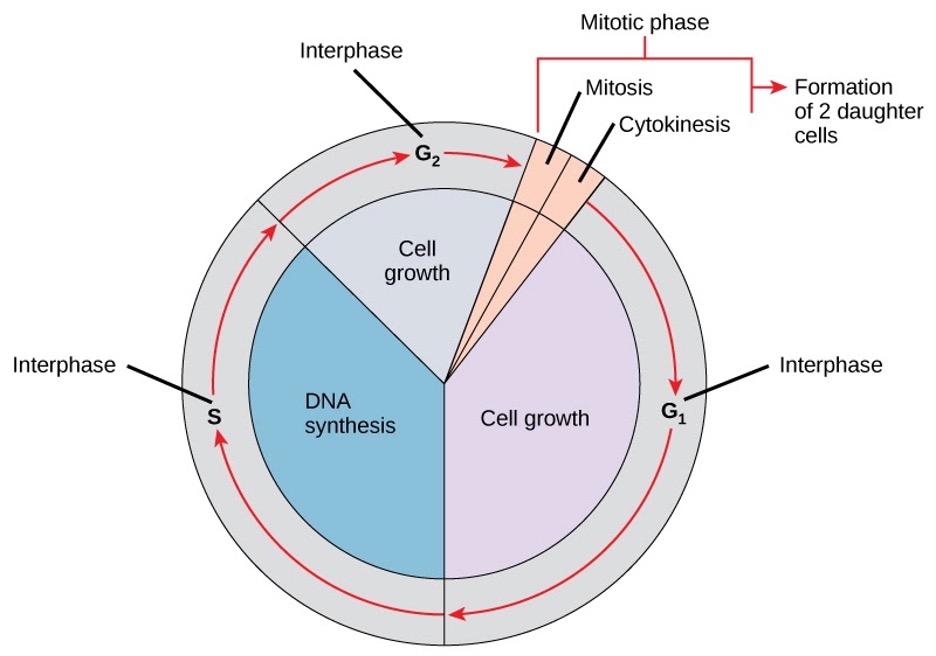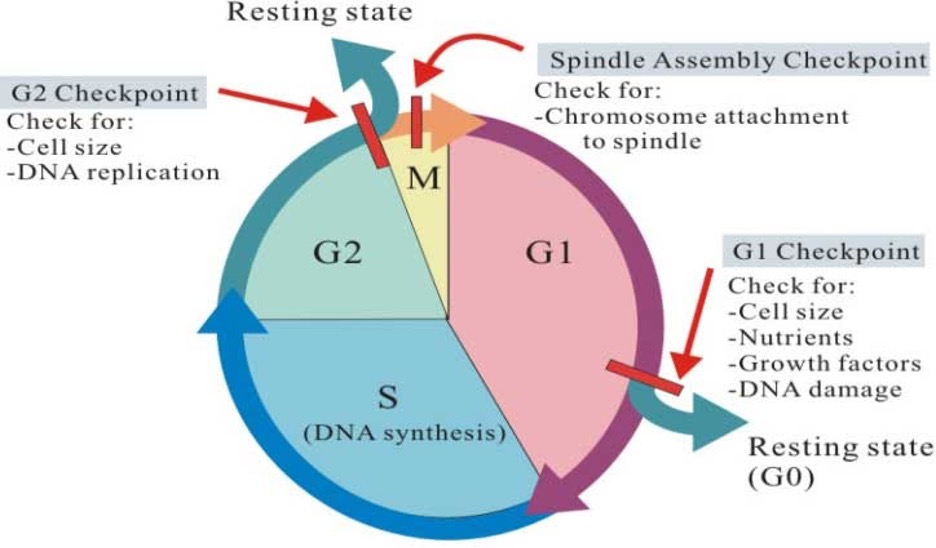By Mohamed Mahmoud
Have you ever wondered how cells grow, divide? Or how these processes are controlled? In this article, we are taking you through a tour that will answer all of your questions. The human body contains about 37.2 trillion cells. All of these cells are derived from only one fertilized egg. The development of such a fertilized egg into an entire organism requires this egg and its descendants to grow and divide. Cells do so by undergoing a series of highly orchestrated cellular events that compose what is called the cell cycle. The cell cycle is composed of two main stages – interphase and mitotic phase (M phase). Interphase consists of three phases: G1, S, and G2 phases while the M phase consists of 2 main phases: Mitosis/ karyokinesis (nucleus division) and cytokinesis (cytoplasmic division) (figure 1). It is important to know that, in order for cells to enter the cell cycle, they need stimulating signals such as growth factors that induce cell cycle entry.

Figure 1: Cell cycle phases.
In interphase, cells start their preparation for their division and therefore need to make sure they have adequate amounts of cellular components such as proteins, nucleic acid, organelles, and energy. Such cellular components will be later distributed to the 2 daughter cells and therefore any deficiencies would disrupt the whole process. In the G1 phase, cellular components except DNA are duplicated and the cell starts growing. In the S phase, the cell genetic material, DNA, is duplicated. In the G2 phase, the last phase of interphase, the cell starts replenishing depleted components that were used in the S phase and finalizes its growth.
When the cell is ready and well prepared, it proceeds to the first part of the M phase, mitosis. In mitosis, the nucleus divides into 2 nuclei by undergoing 5 phases: prophase, prometaphase, metaphase, anaphase, and telophase. The aim of these phases is to distribute the duplicated genetic material into 2 nuclei through different steps, as depicted in figure 2. When two nuclei are formed, the cytoplasm divides in the second part of the M phase, cytokinesis, and two new cells form.

Figure 2:Mitosis and cytokinesis of M phase.
Seeing the complexity of cell division begs the question – how is the cell cycle regulated? How do cells make sure they are ready for each phase? Cells do so by having 3 main “checkpoints”: G1, G2, and M checkpoints with each checkpoint making sure the cell is ready to proceed. Each checkpoint has its own requirement as depicted in figure 3. For example, the G1 checkpoint decides whether or not the cell is to enter the cell cycle. It checks for the presence of growth factors, nutrients, absence of DNA damage, and appropriate cell size. If the cell fulfills all of these requirements, then it is allowed to proceed. If not, the cell enters a phase called the G0 phase, a phase in which the cell is inactive and does not prepare for growth or division. Cells in the G0 phase that are capable of re-entering the cell cycle and are called quiescent cells while others that reside in the G0 phase forever are called senescent cells. During the G2 checkpoint, the cell checks to see if the DNA has properly duplicated and if the cell has the correct size. If these requirements are fulfilled, then the cell proceeds to the M phase. During the M checkpoint, the cell checks for chromosome attachment to the spindle fibers.

Figure 3:Cell cycle checkpoints.
These checkpoints are regulated via two main classes of regulatory proteins: cyclins and cyclin-dependent kinases (CDKs). These molecules act as indicators for cell readiness. Just like hall passes in school, these molecules act as passkeys to signal to the cell to continue through the cell cycle Each cell cycle phase has its own cyclins and CDKs that when the cell is ready, the abundance of these regulatory molecules is enough to make the cell proceed to the next phase of the cell cycle. Some cells, like cancer cells, can override and avoid checkpoint regulation and therefore can proceed through the phases despite having a lot of DNA damage and undesired growth conditions. Our understanding of the cell cycle and how it is being regulated helps us develop effective therapeutics that can be used for cancer treatment. For example, flavopiridol (Alvocidib), a CDK inhibitor, is one of such therapeutics that induces cell cycle arrest in cancer cells and is showing promising results in clinical trials.
